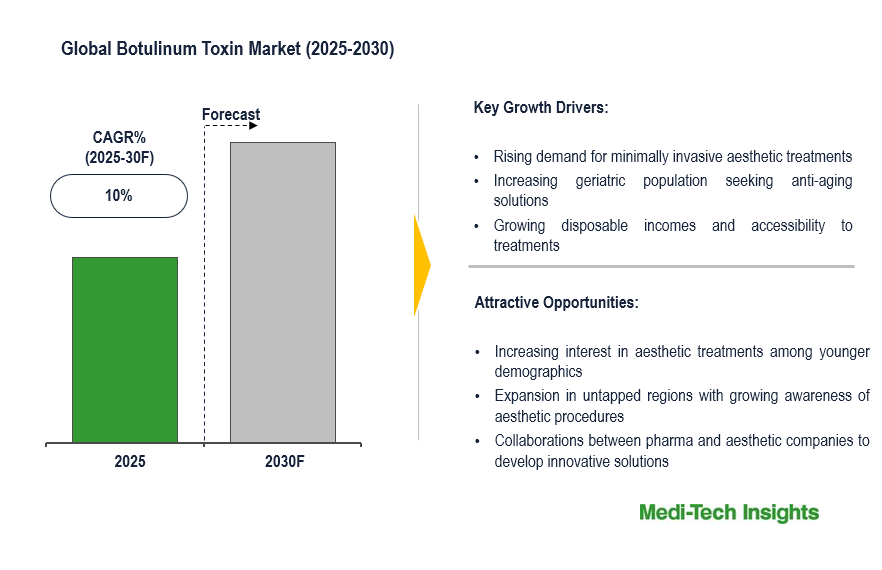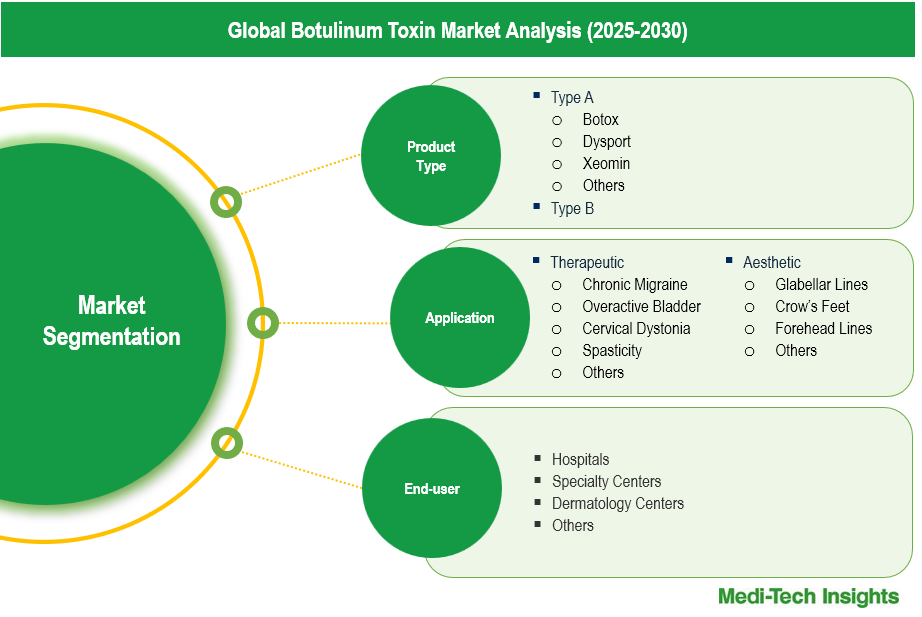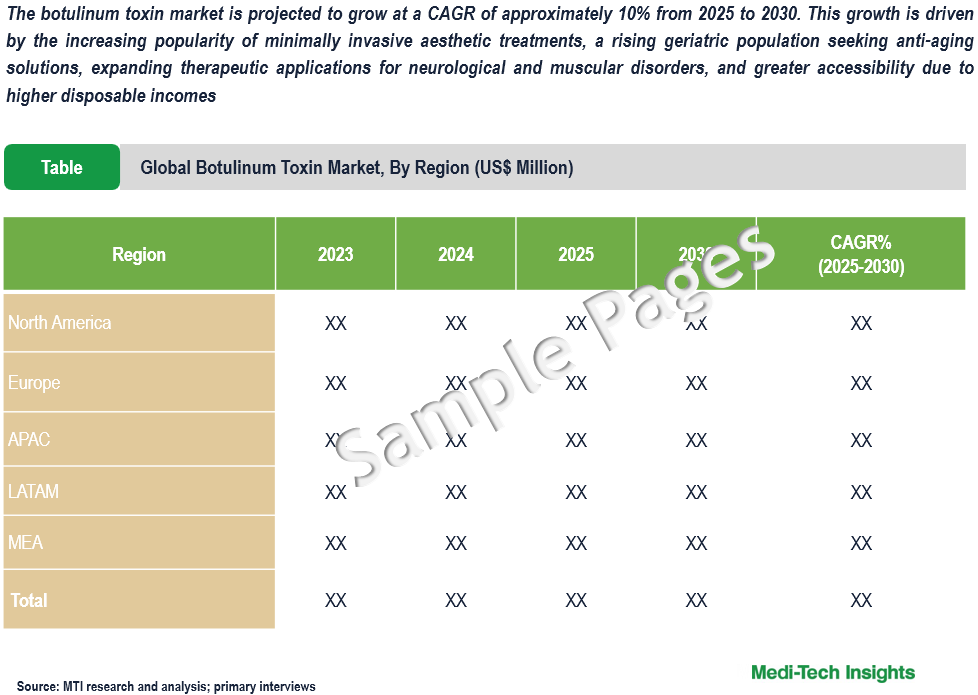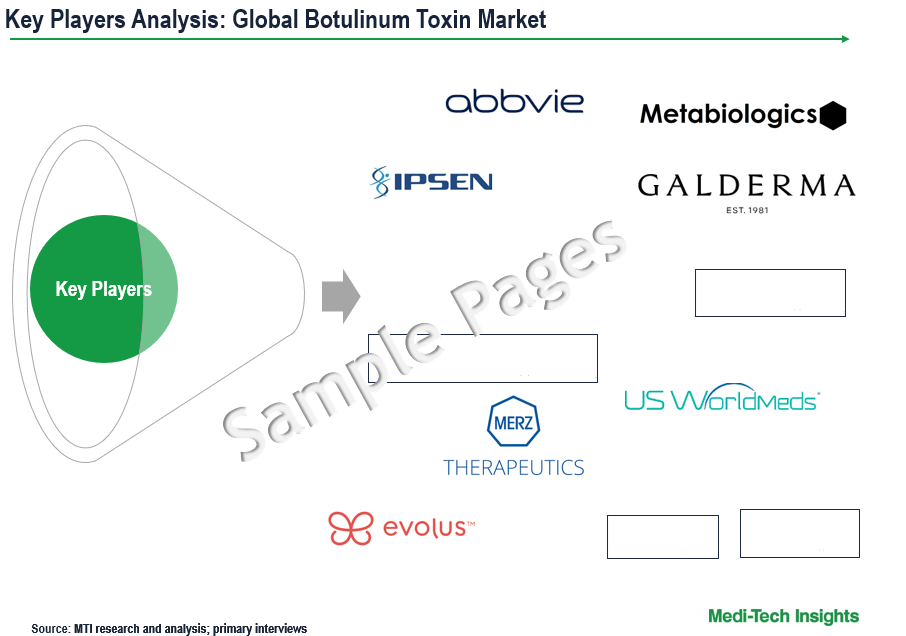
Global Botulinum Toxin Market Size & Trends Report Segmented by Product Type (Type A and Type B), Application (Therapeutic and Aesthetics), End-user (Hospitals, Specialty Clinics, and Others), & Regional Forecast to 2030
The botulinum toxin market is projected to grow at a CAGR of approximately 10% from 2025 to 2030. This growth is driven by the increasing popularity of minimally invasive aesthetic treatments, the rising geriatric population seeking anti-aging solutions, expanding therapeutic applications for neurological and muscular disorders, and greater accessibility due to higher disposable incomes. However, the market faces challenges like high treatment costs, potential side effects, and stringent regulatory processes, which may impact adoption rates and approvals. To learn more about the research report, download a sample report.
Report Overview
The botulinum toxin market revolves around products derived from the neurotoxin Clostridium botulinum, widely utilized for both therapeutic and cosmetic purposes. These products are instrumental in treating medical conditions like chronic migraines, muscle spasticity, and hyperhidrosis, while also being a cornerstone in aesthetic procedures aimed at reducing wrinkles and fine lines. The market benefits from a dual appeal to medical and aesthetic applications, fueled by advancements in formulations and precise delivery techniques, ensuring enhanced efficacy and safety.

To learn more about this report, download the PDF brochure
Increasing Demand for Aesthetic Procedures
The surging demand for minimally invasive aesthetic procedures stands out as a major factor fueling market growth. With a growing societal focus on appearance and confidence, botulinum toxin treatments have gained widespread acceptance for their ability to deliver natural-looking results with minimal downtime. The influence of social media, combined with a shift in cultural norms that encourages both men and women to explore cosmetic enhancements, has amplified this trend. Furthermore, these treatments are more cost-effective and safer compared to surgical alternatives, making them a preferred choice across diverse demographics. Emerging markets are also contributing significantly, as rising awareness and accessibility expand the global customer base. This growing demand for cosmetic procedures has solidified botulinum toxin's position as a cornerstone of aesthetic medicine.
Pioneering Advancements: Expanding Therapeutic Applications
Innovations in therapeutic applications are driving the market's evolution. Botulinum toxin has expanded beyond aesthetics, with approvals for treating chronic migraines, cervical dystonia, and overactive bladder, among others. Ongoing research into potential uses for depression, gastrointestinal disorders, and neuropathic pain highlights its versatility as a therapeutic agent. Additionally, delivery systems, such as microneedle arrays and advanced injection devices, enhance precision and minimize side effects, significantly improving patient outcomes. These advancements not only open new revenue streams but also attract investment in R&D, establishing botulinum toxin as a multifaceted solution for diverse medical needs.

To learn more about this report, download the PDF brochure
Competitive Landscape Analysis
Some of the key players in the global botulinum toxin market include Ipsen Group; AbbVie Inc.; Metabiologics; Merz Pharma; US Worldmeds; Evolus; Galderma; Medytox; HUGEL, Inc. and Supernus Pharmaceuticals, Inc. among others.
Report Scope
| Report Metric | Details |
| Base Year Considered | 2024 |
| Historical Data | 2023 - 2024 |
| Forecast Period | 2025 – 2030 |
| Growth Rate | 10% |
| Market Drivers |
|
| Attractive Opportunities |
|
| Segment Scope | Product Type, Application, and End-user |
| Regional Scope |
|
| Key Companies Mapped | Ipsen Group; AbbVie Inc.; Metabiologics; Merz Pharma; US Worldmeds; Evolus; Galderma; Medytox; HUGEL, Inc. and Supernus Pharmaceuticals, Inc. among others |
| Report Highlights | Market Size & Forecast, Growth Drivers & Restraints, Trends, Competitive Analysis |
Global Botulinum Toxin Market Segmentation
This report by Medi-Tech Insights provides the size of the global botulinum toxin market at the regional- and country-level from 2023 to 2030. The report further segments the market based on product type, application and end-user.
-
Market Size & Forecast (2023-2030), By Product Type, USD Million
- Type A
- Botox
- Dysport
- Xeomin
- Others
- Type B
- Type A
-
Market Size & Forecast (2023-2030), By Application, USD Million
- Therapeutic
- Chronic Migraine
- Overactive Bladder
- Cervical Dystonia
- Spasticity
- Others
- Aesthetic
- Glabellar Lines
- Crow’s Feet
- Forehead Lines
- Others
- Therapeutic
-
Market Size & Forecast (2023-2030), By End-user, USD Million
- Hospitals
- Specialty Clinics
- Cosmetic Centers
- Others
-
Market Size & Forecast (2023-2030), By Region, USD Million
- North America
- US
- Canada
- Europe
- UK
- Germany
- Italy
- Spain
- Rest of Europe
- Asia Pacific
- China
- India
- Japan
- Rest of Asia Pacific
- Latin America
- Middle East & Africa
- North America
Key Strategic Questions Addressed
- What is the market size & forecast of the botulinum toxin market?
- What are historical, present, and forecasted market shares and growth rates of various segments and sub-segments of the botulinum toxin market?
- What are the key trends defining the market?
- What are the major factors impacting the market?
- What are the opportunities prevailing in the market?
- Which region has the highest share in the global market? Which region is expected to witness the highest growth rate in the next 5 years?
- Who are the major players operating in the market?
- What are the key strategies adopted by players?
- Introduction
- Introduction
- Market Scope
- Market Definition
- Segments Covered
- Regional Segmentation
- Research Timeframe
- Currency Considered
- Study Limitations
- Stakeholders
- List of Abbreviations
- Key Conferences and Events (2025-2026)
- Research Methodology
- Secondary Research
- Primary Research
- Market Estimation
- Bottom-Up Approach
- Top-Down Approach
- Market Forecasting
- Executive Summary
- Botulinum Toxin Market Snapshot (2025-2030)
- Segment Overview
- Regional Snapshot
- Competitive Insights
- Market Overview
- Market Dynamics
- Drivers
- Rising demand for minimally invasive aesthetic treatments
- Increasing geriatric population seeking anti-aging solutions
- Growing disposable incomes and accessibility to treatments
- Expanding therapeutic applications (e.g., migraines, muscle spasticity)
- Advancements in product formulations ensuring safety and efficacy
- Restraints
- High treatment costs
- Potential side effects and safety concerns deterring some consumers
- Complex regulatory approval processes delaying market entry
- Opportunities
- Increasing interest in aesthetic treatments among younger demographics
- Expansion in untapped regions with growing awareness of aesthetic procedures
- Collaborations between pharma and aesthetic companies to develop innovative solutions
- Key Market Trends
- Innovations in delivery methods like microneedle arrays for improved outcomes
- Growing focus on combination therapies to enhance treatment efficacy
- Unmet Market Needs
- Industry Speaks
- Global Botulinum Toxin Market Size & Forecast (2023-2030), By Product Type, USD Million
- Introduction
- Type A
- Botox
- Dysport
- Xeomin
- Others
- Type B
- Global Botulinum Toxin Market Size & Forecast (2023-2030), By Application, USD Million
- Introduction
- Therapeutic
- Chronic Migraine
- Overactive Bladder
- Cervical Dystonia
- Spasticity
- Others
- Aesthetic
- Glabellar Lines
- Crow’s Feet
- Forehead Lines
- Others
- Global Botulinum Toxin Market Size & Forecast (2023-2030), By End-user, USD Million
- Introduction
- Hospitals
- Specialty Centers
- Cosmetic Centers
- Others
- Global Botulinum Toxin Market Size & Forecast (2023-2030), By Region, USD Million
- Introduction
- North America Botulinum Toxin Market Size & Forecast (2023-2030), By Country, USD Million
- US
- Market Size & Forecast, By Product Type (USD Million)
- Market Size & Forecast, By Application (USD Million)
- Market Size & Forecast, By End-user (USD Million)
- Canada
- Market Size & Forecast, By Product Type (USD Million)
- Market Size & Forecast, By Application (USD Million)
- Market Size & Forecast, By End-user (USD Million)
- US
- Europe Botulinum Toxin Market Size & Forecast (2023-2030), By Country, USD Million
- UK
- Market Size & Forecast, By Product Type (USD Million)
- Market Size & Forecast, By Application (USD Million)
- Market Size & Forecast, By End-user (USD Million)
- Germany
- Market Size & Forecast, By Product Type (USD Million)
- Market Size & Forecast, By Application (USD Million)
- Market Size & Forecast, By End-user (USD Million)
- Italy
- Market Size & Forecast, By Product Type (USD Million)
- Market Size & Forecast, By Application (USD Million)
- Market Size & Forecast, By End-user (USD Million)
- Spain
- Market Size & Forecast, By Product Type (USD Million)
- Market Size & Forecast, By Application (USD Million)
- Market Size & Forecast, By End-user (USD Million)
- Rest of Europe
- Market Size & Forecast, By Product Type (USD Million)
- Market Size & Forecast, By Application (USD Million)
- Market Size & Forecast, By End-user (USD Million)
- UK
- Asia Pacific (APAC) Botulinum Toxin Market Size & Forecast (2023-2030), By Country, USD Million
- China
- Market Size & Forecast, By Product Type (USD Million)
- Market Size & Forecast, By Application (USD Million)
- Market Size & Forecast, By End-user (USD Million)
- Japan
- Market Size & Forecast, By Product Type (USD Million)
- Market Size & Forecast, By Application (USD Million)
- Market Size & Forecast, By End-user (USD Million)
- India
- Market Size & Forecast, By Product Type (USD Million)
- Market Size & Forecast, By Application (USD Million)
- Market Size & Forecast, By End-user (USD Million)
- Rest of Asia Pacific
- Market Size & Forecast, By Product Type (USD Million)
- Market Size & Forecast, By Application (USD Million)
- Market Size & Forecast, By End-user (USD Million)
- China
- Latin America (LATAM) Botulinum Toxin Market Size & Forecast (2023-2030), USD Million
- Market Size & Forecast, By Product Type (USD Million)
- Market Size & Forecast, By Application (USD Million)
- Market Size & Forecast, By End-user (USD Million)
- Middle East & Africa (MEA) Botulinum Toxin Market Size & Forecast (2023-2030), USD Million
- Market Size & Forecast, By Product Type (USD Million)
- Market Size & Forecast, By Application (USD Million)
- Market Size & Forecast, By End-user (USD Million)
- Competitive Landscape
- Key Players and their Competitive Positioning
- Key Player Comparison
- Segment-wise Player Mapping
- Market Share Analysis (2024)
- Company Categorization Matrix
- Dominants/Leaders
- New Entrants
- Emerging Players
- Innovative Players
- Key Strategies Assessment, By Player (2022-2024)
- New Product Launches
- Partnerships, Agreements, & Collaborations
- Mergers & Acquisitions
- Geographic Expansion
- Key Players and their Competitive Positioning
- Company Profiles*
(Business Overview, Financial Performance**, Products Offered, Recent Developments)
- Ipsen Group
- AbbVie Inc.
- Metabiologics
- Merz Pharma
- US Worldmeds
- Evolus
- Galderma
- Medytox
- HUGEL, Inc.
- Supernus Pharmaceuticals, Inc.
- Other Prominent Players
Note: *Indicative list
**For listed companies
The study has been compiled based on extensive primary and secondary research.
Secondary Research (Indicative List)

Primary Research
To validate research findings (market size & forecasts, market segmentation, market dynamics, competitive landscape, key industry trends, etc.), extensive primary interviews were conducted with both supply and demand-side stakeholders.
Supply Side Stakeholders:
- Senior Management Level: CEOs, Presidents, Vice-Presidents, Directors, Chief Technology Officers, Chief Commercial Officers
- Mid-Management Level: Product Managers, Sales Managers, Brand Managers, R&D Managers, Business Development Managers, Consultants
Demand Side Stakeholders:
- Stakeholders from Hospitals, Specialty Centers and Others
Breakdown of Primary Interviews

Market Size Estimation
Both ‘Top-Down & Bottom-Up Approaches’ were used to derive market size estimates and forecasts
Data Triangulation
Research findings derived through secondary sources & internal analysis was validated with Primary Interviews, Internal Knowledge Repository and Company’s Sales Data



